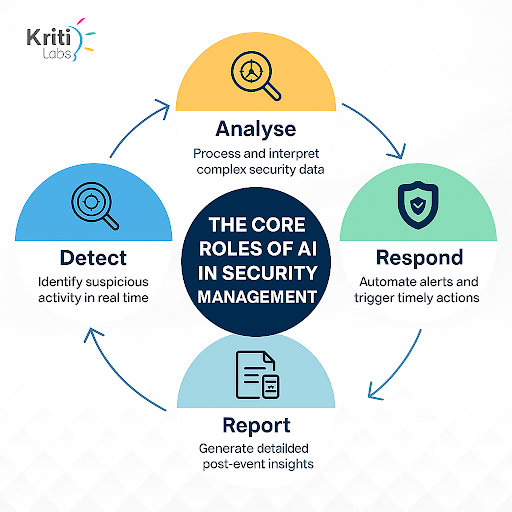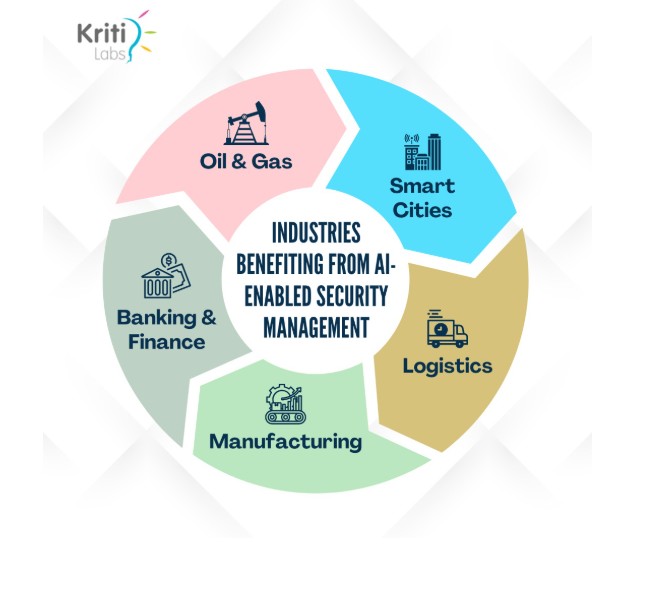What Can Be the Role of AI in Security Management?
Modern organisations face an increasingly complex mix of security challenges. From large industrial campuses to smart cities, the need for quick, data-driven, and reliable decision-making has never been greater. Security is no longer just about guards and cameras; it has become about understanding behaviour, anticipating risks, and responding intelligently to threats in real time.
This is where Artificial Intelligence (AI) has begun to redefine the future of security management. By learning from data and identifying patterns that humans may miss, AI has the potential to make security systems faster, smarter, and far more adaptive.
Security management refers to the systematic process of protecting people, property, and information.
It involves monitoring, detecting, analysing, and responding to incidents while ensuring compliance
with regulatory standards.
Traditionally, this was achieved through manual oversight, human-led decision-making, and reactive
responses. However, as operations have scaled and risks have multiplied, these methods are no longer enough.
AI brings automation and intelligence that shift security from reactive to proactive. By analysing real-time
data from video feeds, sensors, and access systems, AI enables faster and more accurate detection of unusual
activity. It supports—rather than replaces—security personnel by providing insights and predictive alerts.
AI algorithms can identify anomalies or suspicious activity within seconds, such as unusual movement,
unauthorised entries, or lingering behaviour. Predictive analysis helps identify risks before they escalate.
Using facial recognition and biometric verification, AI ensures only authorised individuals access
restricted areas. When combined with IoT devices, access is automated and fully auditable.
AI automatically categorises incidents, generates reports, and highlights causes and patterns, simplifying
post-event analysis and improving future response strategies.
AI learns recurring behaviour patterns—such as repeated visits to restricted zones or vehicles deviating
from routes—and raises alerts based on behaviour, not just rules.
Real-time analysis helps security teams act instantly, reducing incident impact.
Machine learning models reduce false alarms and prioritise critical alerts.
Automation streamlines operations, reducing the need for manual checkpoints and enabling smarter allocation
of manpower.
AI predicts potential incidents using historical patterns, allowing organisations to prevent rather than
respond to threats.
Used for crowd monitoring, traffic management, and public safety. AI flags abandoned objects and unusual
gatherings, supporting law enforcement.
AI tracks vehicles, monitors restricted zones, and ensures cargo safety. Combined with IoT locks and GPS,
it offers full visibility.
AI detects unsafe behaviour, monitors machinery health, and ensures compliance, improving worker safety
and reducing downtime.
AI enables access monitoring, ATM protection, and fraud pattern detection, strengthening security and trust.
IoT devices—sensors, cameras, smart locks—collect continuous data. AI analyses this data to detect risks
and trigger automated actions.
For example, if a temperature sensor detects overheating and AI correlates it with movement near a restricted
area, it may trigger an automatic shutdown or alarm.
This integration creates centralised command-and-control systems where all devices communicate, providing
complete situational awareness.
Kritilabs’ VAIOT suite blends AI, IoT, and real-time video analytics to support complex infrastructures
such as logistics hubs, industrial plants, and smart cities.
VAIOT enhances security, safety, and regulatory confidence by enabling smarter and more responsive
security ecosystems.
Future systems will learn context, predict incidents with even higher accuracy, and coordinate autonomous
actions with minimal intervention.
Ethical AI, responsible monitoring, and sustainability will also play major roles as organisations adopt
secure, energy-efficient systems.
AI is transforming security—from reactive observation to proactive strategy. By integrating AI with IoT,
organisations can create safer, smarter, and more efficient environments powered by real-time intelligence.
With advanced platforms like VAIOT, Kritilabs leads the shift toward intelligent, proactive security
management.
AI automates surveillance, detects anomalies, and provides predictive alerts by analysing data from cameras,
sensors, and IoT devices.
No. AI complements human teams by automating monitoring, while humans handle decisions, ethics, and complex
incidents.
Real-time video analytics, automated access control, perimeter monitoring, behaviour analysis, and
incident reporting.
The VAIOT suite combines AI and IoT for automated alerts, intelligent analytics, asset monitoring, and
compliance support across logistics, manufacturing, and smart cities.
Enhanced situational awareness, faster response times, automated actions, and centralised control.
Yes. It scales across logistics, oil & gas, manufacturing, banking, smart cities, and more, adapting to
compliance and operational needs.
What Is Security Management and Where AI Fits In?
The Role of AI in Security Management
1. Threat Detection and Predictive Alerts
2. Automated Access Control
3. Incident Analysis and Reporting
4. Behavioural Pattern Recognition
Benefits of AI-Driven Security Management
1. Faster Response Time
2. Enhanced Accuracy

3. Cost Efficiency
4. Proactive Prevention
Industry Use Cases
1. Smart Cities
2. Logistics and Transportation
3. Manufacturing and Industrial Facilities
4. Banking and Financial Services

How AI Integrates with IoT for Enhanced Security
Kritilabs’ Role in AI-Enabled Security Management
The Future of Security Management with AI
Conclusion
Frequently Asked Questions (FAQs)
1. How does AI improve security management systems?
2. Can AI completely replace human security teams?
3. What are some practical applications of AI in physical security?
4. How does Kritilabs use AI in its security solutions?
5. What are the benefits of integrating AI with IoT in security management?
6. Is AI-driven security management suitable for all industries?

